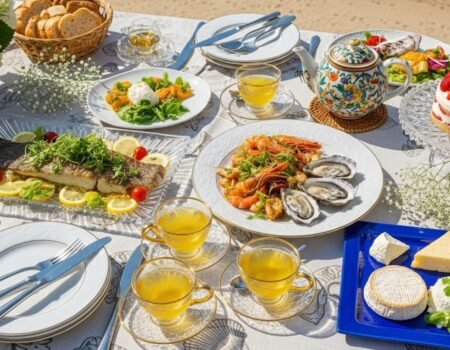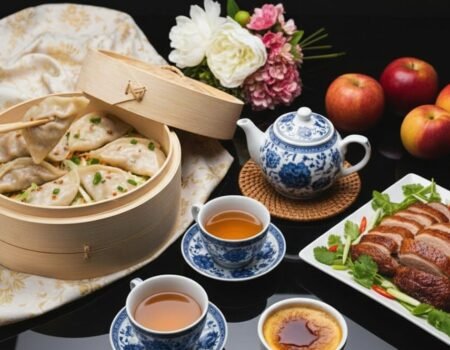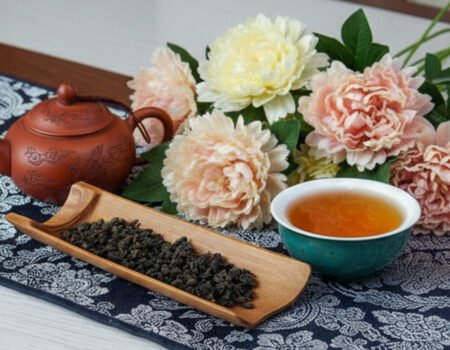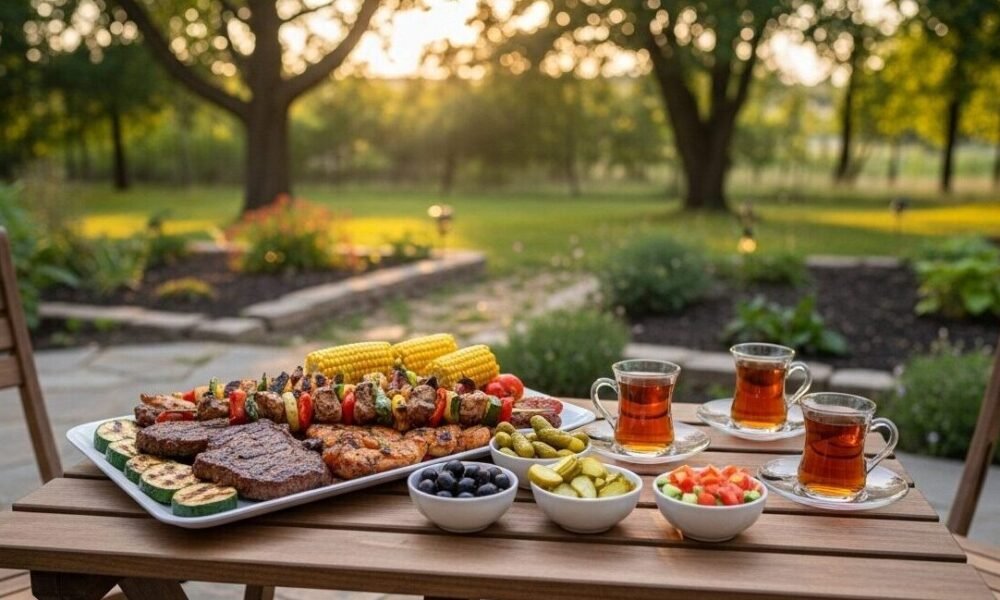
Ultimate Tea Tasting Pairing Guide: Flavourful Food and Tea Pairing Tips
Index
Index
Finding the right food to pair with your favorite tea can feel like a puzzle with too many pieces. Tea tasting pairing works much like wine pairing, with each tea type offering unique flavor notes that match certain foods.
This guide will show you how to create perfect matches between your cup of tea and your meal or snack.
Key Takeaways
- Match tea strength with food intensity for the best pairings—bold black teas with hearty meals, delicate white teas with light foods.
- Tea pairing works through both complementary matches (similar flavors) and contrasting combinations (opposite flavors that balance each other).
- Green teas pair well with seafood, light proteins, and fruit-based desserts, with each variety (vegetal, grassy, smoky, fruity) matching specific foods.
- Black teas like Assam and Ceylon stand up to rich foods, with fruity varieties complementing desserts and smoky types pairing with bold cheeses and grilled meats.
- Oolong and Pu-erh teas offer versatile pairing options—light oolongs with seafood and pastries, dark oolongs with spicy dishes, and earthy pu-erh cutting through fatty foods.
General Principles of Tea and Food Pairing
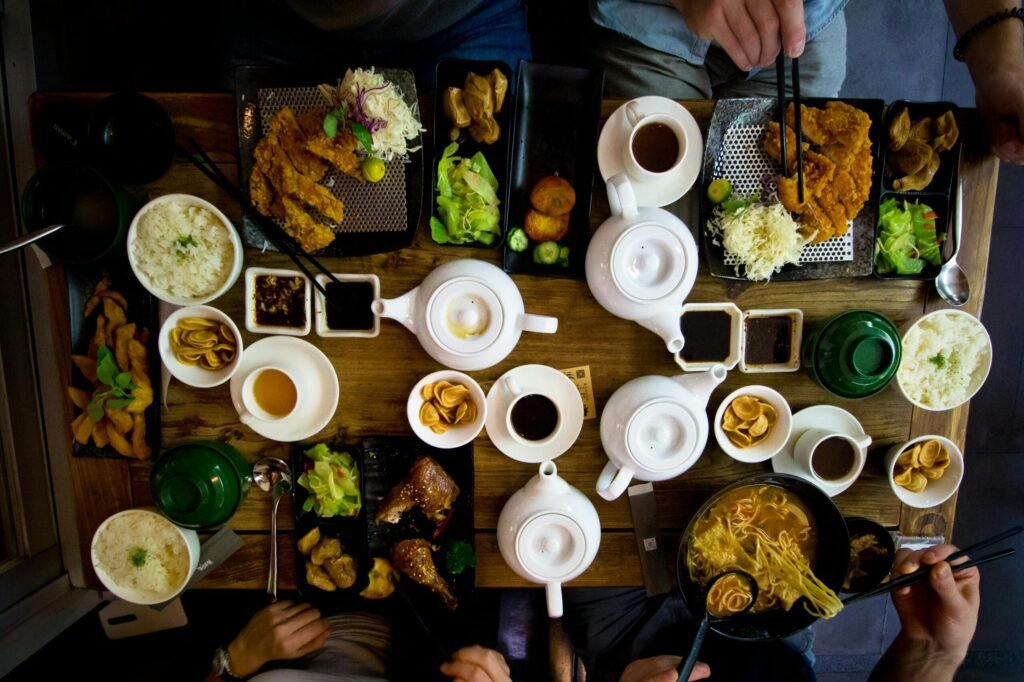
Tea and food pairing follows simple rules that make both taste better. The right match enhances flavors, creates balance, and turns a simple cup into a complete sensory experience.
Matching Intensity
The basic rule of tea pairing starts with matching flavor strength. Bold black teas like Assam stand up perfectly to hearty Sunday roasts and rich mashed potatoes without losing their character.
The robust flavors in these full-bodied teas complement rather than compete with substantial meals. Light and delicate white teas such as Silver Needle pair better with subtle foods like white fish or fresh fruit salads.
This balance ensures neither the food nor the tea overpowers the other.
Tea sommeliers focus on intensity alignment as their first consideration in creating successful pairings. Pu-erh tea, with its deep earthy profile, cuts through greasy or oily dishes and aids digestion.
Green teas offer moderate intensity that works well with chicken and vegetable dishes. The goal remains simple: match the tea’s strength to your food’s boldness for a harmonious tasting experience that brings out the best flavors in both.
Complementary vs. Contrasting Flavors

Tea pairing works in two main ways: through flavors that match or flavors that balance each other. Complementary pairings create harmony by matching similar notes, like delicate white teas with light pastries or robust black teas with hearty meat dishes.
This approach builds on shared flavor elements and creates a smooth taste experience. Many tea experts suggest starting with these natural matches before trying more complex combinations.
Contrasting pairings create excitement by balancing opposite flavors against each other. The creamy richness of cheese cuts through the astringency of Earl Grey tea, while smoked teas provide a bold counterpoint to strong cheeses.
These combinations work because they balance sweetness, bitterness, and acidity across both the food and drink. Successful contrasting pairs often surprise guests at tea tastings and add depth to your flavor experience.
Both methods offer valid paths to perfect tea pairings – neither is better, just different approaches to enjoy your cup.
Considering Regional and Seasonal Pairings

Regional food and tea traditions offer natural pairing ideas that have stood the test of time. Japanese green teas like sencha pair perfectly with local seafood dishes, while British black teas complement scones and shortbread cookies.
Seasonal pairings bring fresh harmony to your table—light white teas match spring vegetables, while robust pu-erh teas balance rich autumn meals. Many tea masters suggest matching BBQ meats with smoky Zheng Shan black tea or charcoal-fired oolong for a flavor boost.
The balance between food and tea creates a complete taste experience where neither element overpowers the other.
Next, we’ll explore specific pairing guidelines for white tea, which offers some of the most delicate flavor profiles in the tea world.
Pairing Guidelines for White Tea
White teas offer a subtle canvas for food pairings that respect their delicate nature. Fresh seafood, mild cheeses, and light pastries match the gentle notes in Silver Needle without overpowering them.
Light and Delicate Complements
White tea offers subtle flavors that pair best with light foods. Delicate pastries, vanilla shortbread, and mild fruit tarts match the gentle notes without overwhelming them. Many tea experts suggest enjoying silver needle white tea alone to fully appreciate its honey-like aroma and natural sweetness.
Rich foods mask white tea’s nuanced profile, so avoid heavy cream sauces or spicy dishes. Light cakes, cucumber sandwiches, and mild cheeses make ideal companions for afternoon tea sessions.
The goal remains simple: let the tea’s unique character shine through rather than compete with bold food flavors.
Pairing Guidelines for Green Tea
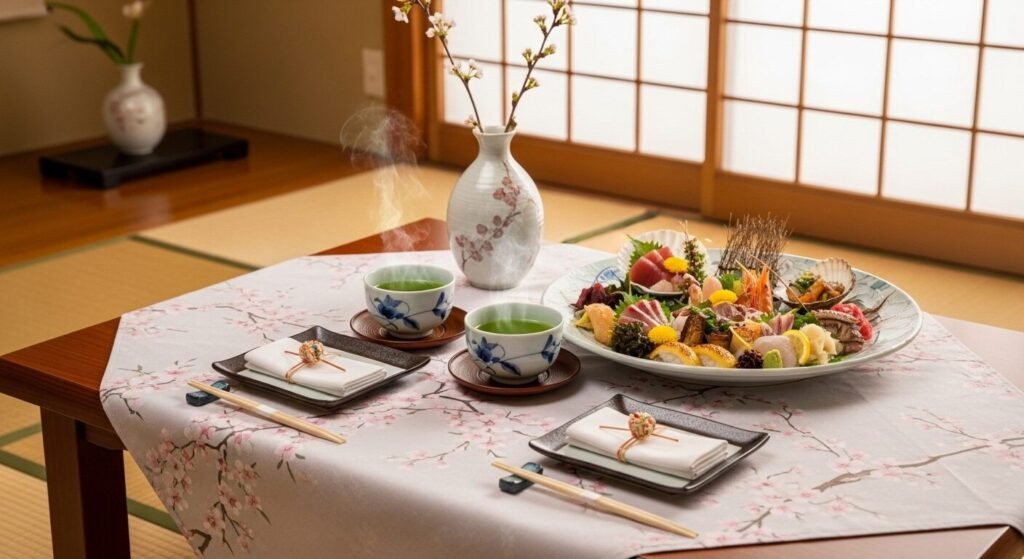
Green tea offers a range of flavors from grassy to nutty that match perfectly with many foods. Try pairing vegetal Japanese sencha with seafood dishes or fruity Dragonwell with white chocolate for a taste adventure.
Savory Pairings for Green Tea
Green tea offers amazing matches with savory foods that bring out its best qualities. Sencha, with its fresh vegetal notes, creates perfect harmony with seafood dishes and sushi plates.
The clean taste of the tea cuts through the richness of fish while highlighting its natural flavors. Smoky varieties like Hojicha stand up boldly to grilled meats, making them ideal companions for barbecue gatherings.
Fruity green teas pair beautifully with light proteins such as chicken. Try pan-fried chicken with a cup of Dragonwell for a satisfying meal combination. The umami qualities in green tea also complement dishes with mushrooms or mild cheeses.
Many tea lovers find that the slight bitterness in some green teas balances fatty foods, creating a more rounded flavor experience on your palate.
Sweet Pairings for Green Tea
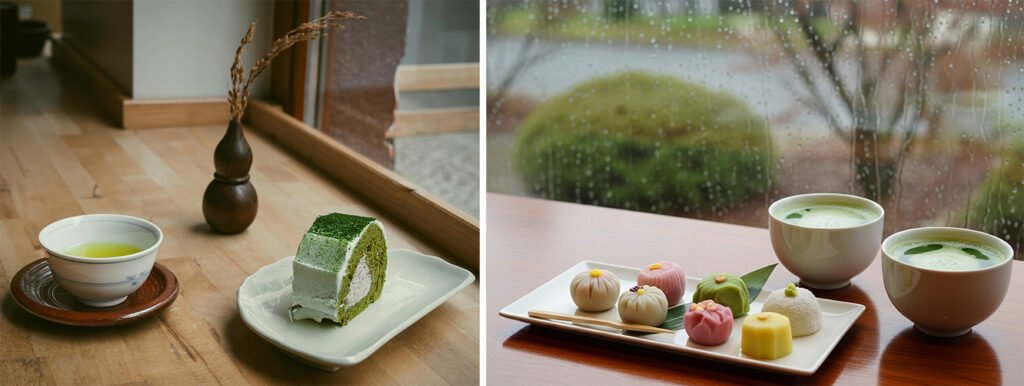
Green tea offers a perfect match for light desserts, especially fruit-based options that won’t overpower its subtle flavors. The grassy notes in green tea create balance with sweet treats like lemon tarts, fruit sorbets, and vanilla cookies.
Matcha-infused desserts showcase this pairing principle perfectly—the tea’s vegetal qualities blend seamlessly with sweet elements in items like matcha cheesecake or matcha-dusted shortbread.
Fruity green tea varieties bring special magic to dessert pairings. They enhance fresh berries, melon slices, and light pastries while cutting through sweetness with their natural astringency.
Try pairing a jasmine green tea with white chocolate or a sencha with apple-based desserts for a taste combination that highlights both elements. These pairings work because they follow the basic rule of flavor pairing: find complementary tastes that enhance rather than compete with each other.
Specific Green Tea Varieties (Fruity, Vegetal, Smoky, Matcha)

Different green tea types offer unique flavor profiles that pair with specific foods. Each variety brings its own character to your table, making food and tea pairing an exciting adventure.

- Vegetal green teas like Dragon Well match perfectly with soft cheeses and seafood dishes, creating a balanced taste experience.
- Grassy varieties such as Sencha complement Asian cuisine, especially sushi and light rice dishes.
- Smoky green teas including Hojicha pair wonderfully with pizza, BBQ meats, and roasted vegetables due to their toasty notes.
- Fruity green teas like Jasmine tea work best with simple sandwiches and fresh fruit platters, enhancing their natural sweetness.
- Matcha powder mixes beautifully with traditional Japanese wagashi sweets that balance its slightly bitter flavor profile.
- Gunpowder tea, with its strong smoky character, stands up well to spicy foods and grilled dishes.
- Longjing tea pairs nicely with light pastries and mild cheeses due to its subtle chestnut flavor.
- Bancha tea complements savory snacks and rice crackers with its light, refreshing taste.
- Gyokuro, a shade-grown tea, works wonderfully with delicate seafood like scallops or mild white fish.
- Kukicha (twig tea) matches well with simple desserts and vanilla-flavored treats.
Now let’s explore the fascinating world of black tea varieties and their ideal food companions.
Pairing Guidelines for Black Tea
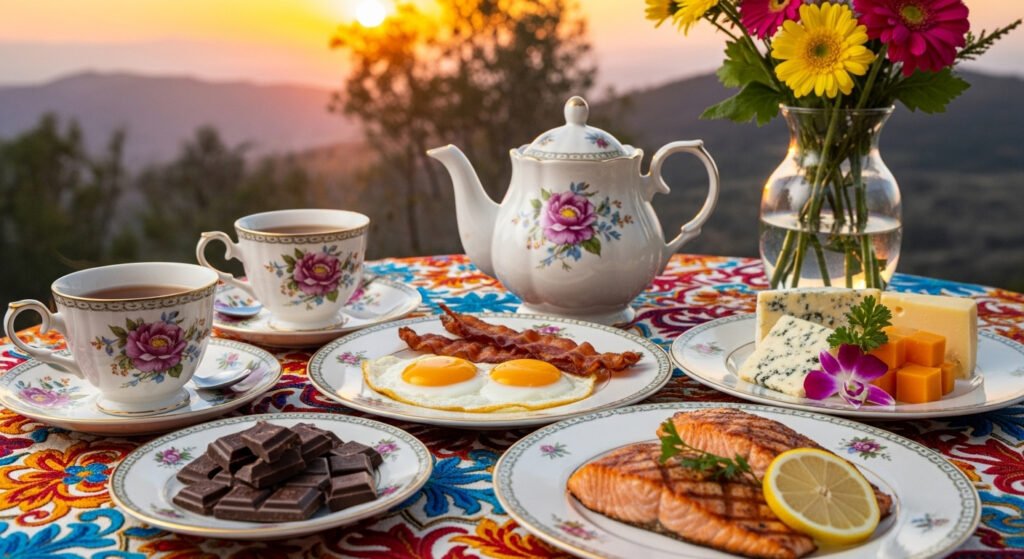
Black tea stands as the boldest member of the tea family, making it perfect for pairing with rich, hearty foods. Its strong character matches well with red meats, spicy dishes, and creamy desserts that would overwhelm lighter teas.
Hearty and Rich Food Complements

Black tea shines brightest alongside hearty dishes that match its bold character. The earthy notes in robust black teas create perfect harmony with Sunday roasts, grilled steaks, and rich stews.
You’ll find Assam or Ceylon varieties stand up well to these meals without getting lost in the mix. Smoky black teas like Lapsang Souchong add depth to Mexican cuisine and pair wonderfully with dark chocolate treats.
Fruity black teas such as Darjeeling complement sweet desserts and pastries by enhancing their natural flavors. The bergamot in Earl Grey tea works magic with citrus-based sweets and buttery baked goods.
For breakfast pairings, try matching black tea with hearty foods like eggs, bacon, or toast with peanut butter to start your day with balanced flavors.
Pairings for Fruity, Earthy/Malty, and Smoky Black Teas
Fruity black teas match perfectly with berry desserts and citrus-based treats that highlight their natural sweetness. Try pairing a fruity Ceylon tea with lemon tarts or strawberry scones for a delightful taste experience.
Earthy and malty black teas like Assam create magic with dark chocolate (70%+), which brings out their rich notes and creates depth. These robust teas also stand up well to hearty dishes such as beef stew or mushroom risotto.
Smoky black teas demand bold food partners that can balance their intense character. Lapsang Souchong tea forms an excellent duo with blue cheese, as the smoky flavor complements the cheese’s strong profile.
Grilled meats, especially duck or salmon, also pair wonderfully with smoky teas, creating a satisfying contrast of flavors. For a surprising combination, try smoky teas with caramel desserts or spicy dishes that feature chipotle peppers.
Specific Black Tea Varieties (Assam, Ceylon, Earl Grey, Darjeeling, Keemun, Nilgiri)
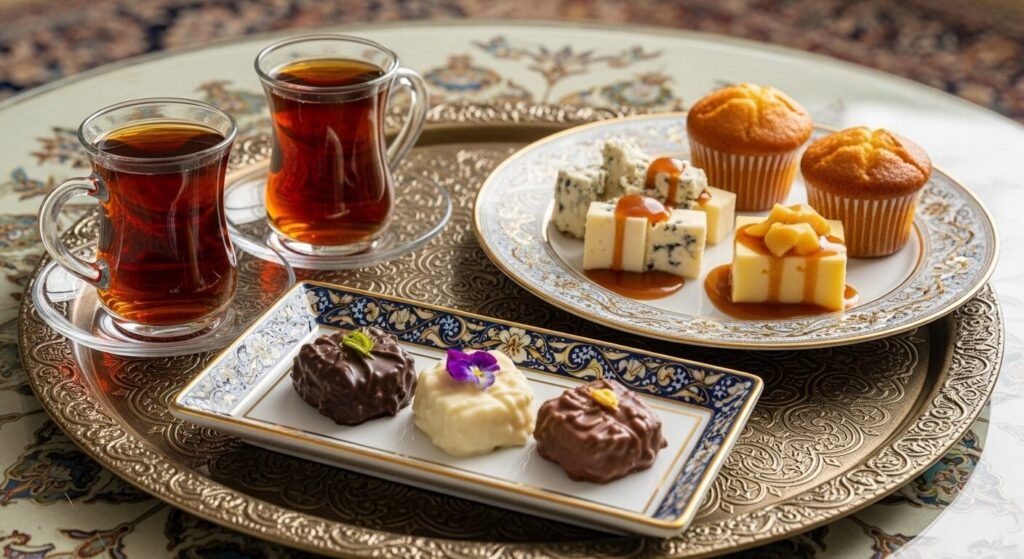
Black teas offer distinct flavor profiles that match beautifully with various foods. Each variety brings unique notes that can enhance your dining experience through thoughtful pairing.
- Assam tea delivers a bold, malty flavor that stands up to aged cheddar cheese. The strong character of this Indian tea balances perfectly with spicy dishes like chicken tikka masala.
- Ceylon tea from Sri Lanka features bright, crisp notes that complement dark chocolate treats. This versatile tea also pairs wonderfully with seafood dishes, especially grilled fish with lemon.
- Earl Grey, flavored with bergamot orange, creates magic when served with white chocolate desserts. The citrus notes in this tea cut through the sweetness of fruity desserts like lemon tart.
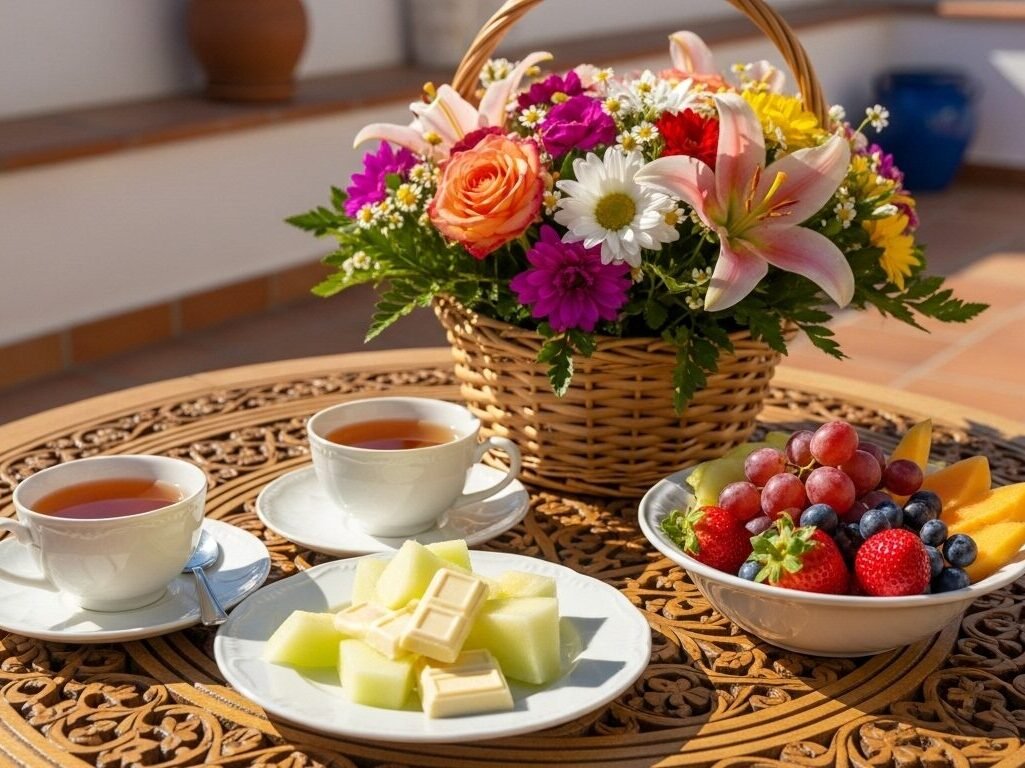
- Darjeeling, often called the “champagne of teas,” offers muscatel grape notes that match well with Indian cuisine. Light pastries and fruity desserts bring out the balanced flavor profile of this prized tea.
- Keemun tea from China provides smoky, wine-like qualities that pair excellently with aged cheddar. The complex flavor notes make this tea a perfect match for chocolate treats and savory meat dishes.
- Nilgiri tea grown in southern India presents aromatic, fragrant qualities suitable for many food pairings. The clean taste works well with both sweet pastries and savory lunch items.
- Black tea varieties can impress your guests when matched correctly with foods from their regions of origin. The art of tea pairing relies on understanding these regional connections.
- Spicy foods gain balance from the tannins in stronger black teas like Assam and Keemun. The tea helps cool the palate between bites of spicy dishes.
- Chocolate and tea create memorable flavor combinations, especially dark chocolate with Ceylon or milk chocolate with Assam. The bitterness of the tea offsets the sweetness of the chocolate.
- Breakfast foods like toast, muffins, and pastries pair naturally with most black teas. The morning tea ritual feels complete with these simple yet satisfying combinations.
Pairing Guidelines for Oolong Tea
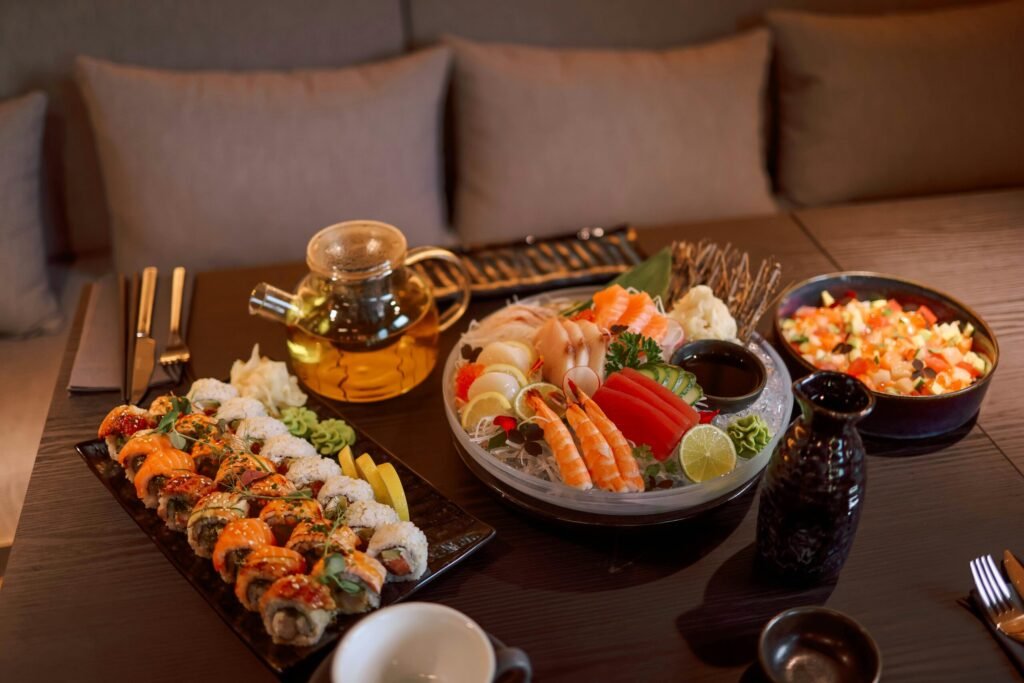
Oolong teas bridge the gap between green and black teas, making them perfect partners for both savory dishes like seafood and sweet treats like pastries – read on to learn how to match light and dark oolongs with foods that bring out their unique floral, fruity, or toasty notes.
Versatile Pairings for Light and Dark Oolongs
Light oolongs offer bright, floral notes that match perfectly with seafood dishes and citrus fruits. These teas create balance with brie, goat cheese, and lighter proteins without overpowering their subtle flavors.
You’ll find the delicate profile of tie guan yin makes an excellent partner for lunchtime salads or morning pastries.
Dark oolongs bring rich, toasty flavors that stand up to bold foods like spicy curries and duck dishes. These robust teas cut through the fat in roasted meats and complement the sharpness of aged cheddar or gouda cheese.
Many tea lovers enjoy dark oolongs with chocolate desserts too, as the caramel notes in the tea highlight the sweetness in confectionery treats.
Savory and Sweet Options
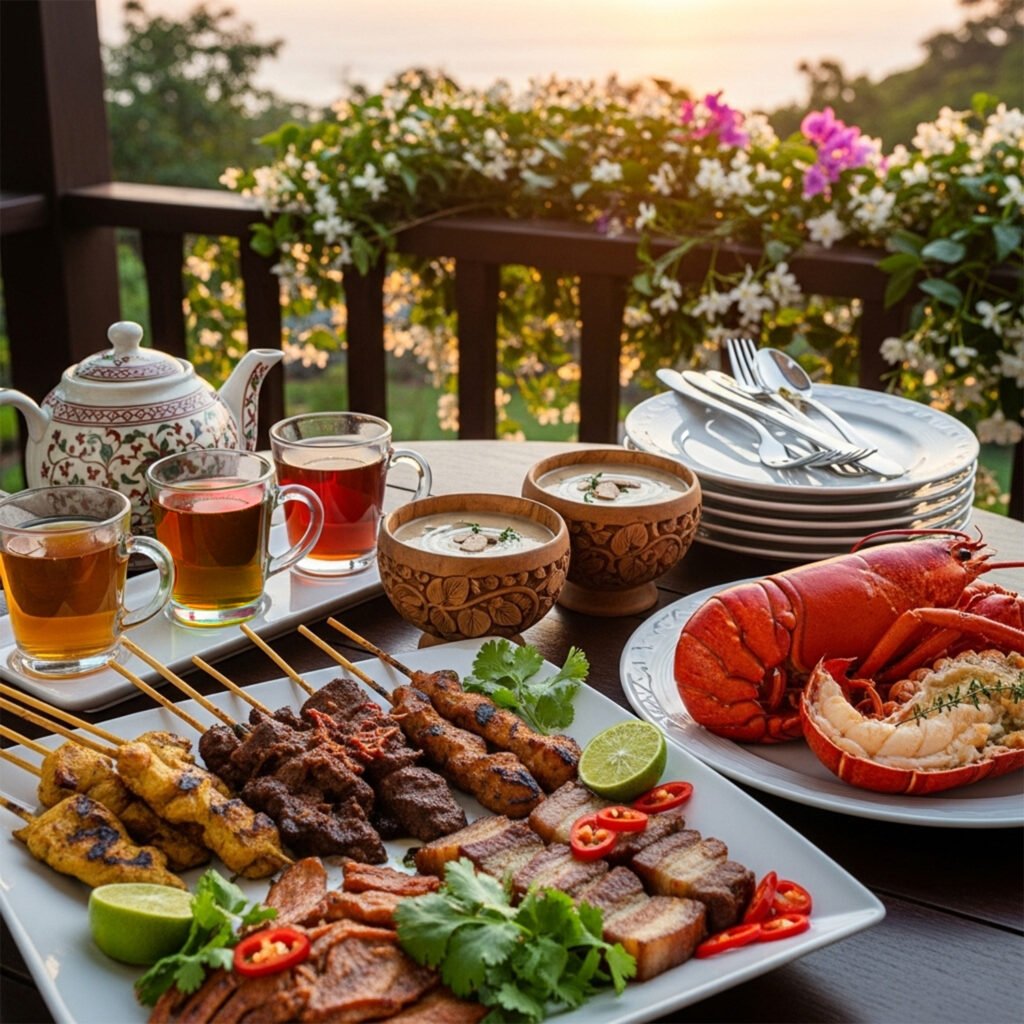
Oolong teas shine with both savory and sweet foods due to their complex flavor profiles. Darker oolongs pair perfectly with hearty dishes like grilled meats, mushroom soups, and lobster.
The rich, toasty notes in these teas cut through fatty foods while enhancing umami flavors. For sweet treats, lighter oolongs bring out the natural sweetness in fruits and pastries.
Try pairing a floral yin oolong with almond cookies or a fruity variety with fresh berries.
Sweet chocolate pairings follow a simple rule with oolongs. Dark chocolate matches wonderfully with darker oolongs, creating depth through complementary flavors. White chocolate works better with lighter oolongs through contrast.
Many tea enthusiasts enjoy how oolong enhances both savory dinners and sweet desserts without overwhelming either. This versatility makes oolong an excellent choice for multi-course meals where you want to serve just one tea throughout.
Pairing Guidelines for Pu-erh Tea
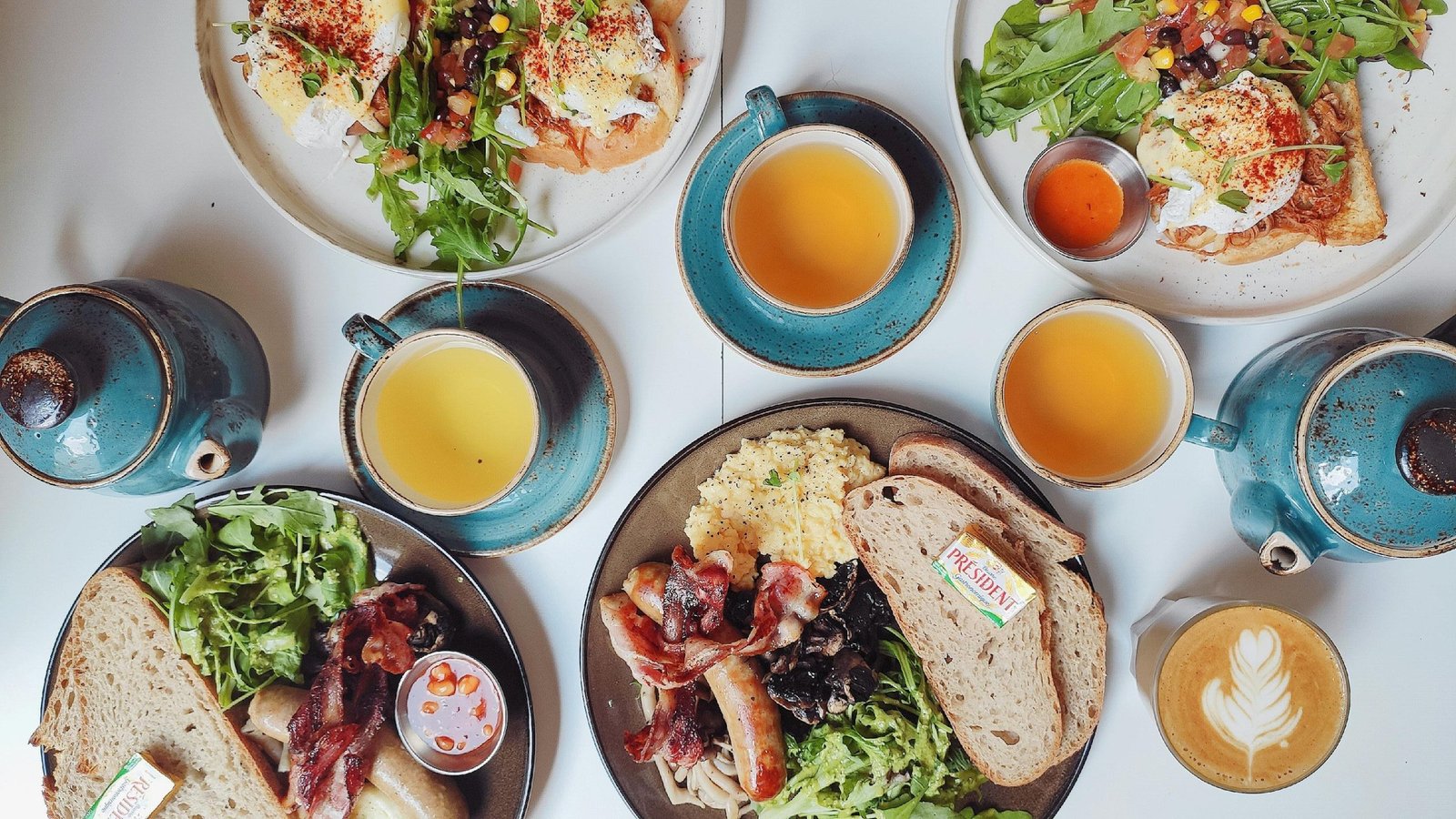
Pu-erh tea’s rich, earthy profile pairs perfectly with fatty foods like duck, aged cheeses, and dark chocolate, as its bold flavor cuts through richness while its fermented qualities aid digestion – discover how this ancient tea can transform your next meal!
Earthy Complements for Rich and Savory Foods
Pu-erh tea stands out as a perfect match for rich, savory dishes thanks to its deep earthy flavor profile. This unique tea cuts through fatty foods and balances robust tastes in hearty meals.
Aged shou pu-erh works magic with dishes like roasted duck, grilled steaks, or mushroom stews. The bold taste of pu-erh doesn’t compete with these foods but instead creates a harmonious balance on your palate.
For the best pairing experience, serve pu-erh with braised meats or stews where its earthy notes complement rather than overpower the meal. The tea acts as a natural palate cleanser between bites of rich food.
Many tea lovers enjoy how pu-erh’s digestive benefits help after heavy meals. Try brewing a pot of aged pu-erh to serve alongside your next holiday feast or Sunday roast – the contrast between the tea’s depth and the savory flavors will create a memorable dining experience.
Pairing Guidelines for Herbal Teas (Tisanes)

Herbal teas open up a world of flavor matches beyond traditional teas, with each blend offering unique pairing chances. Fruity tisanes like hibiscus pair with berry desserts, while floral options like chamomile enhance light pastries and cookies.
Matching Based on Herbal Flavor Profiles (Fruity, Floral, Spicy, Minty)
Tisanes offer a world of flavor beyond traditional teas. The right food pairings can enhance these unique tastes and create perfect harmony on your palate.
- Fruity herbal teas like berry blends and apple cinnamon pair wonderfully with fresh fruits and light pastries. The natural sweetness in both the tea and food creates a pleasant echo of flavors.
- Floral tisanes such as lavender, rose, and chamomile match perfectly with honey-drizzled treats and delicate cookies. These teas bring out the subtle notes in vanilla-based desserts and light cakes.
- Citrus-forward herbal blends complement hibiscus tisane exceptionally well, creating a bright, refreshing taste experience. The tangy notes in both the tea and citrus fruits balance each other beautifully.
- Spicy herbal teas containing cinnamon, ginger, or clove stand up nicely to rich pastries and hearty breads. Chai varieties especially complement both sweet pastries and savory meat dishes.
- Mint tisanes cut through the richness of chocolate desserts and provide a cooling contrast. The clean, sharp taste of mint tea also pairs well with lamb dishes and Mediterranean foods.
- Earthy herbal blends featuring rooibos work beautifully with nutty desserts and caramel flavors. The natural sweetness in rooibos enhances the depth in these food pairings.
- Fennel and anise-based herbal teas match surprisingly well with fish dishes and light seafood. These licorice notes create an interesting contrast with the brininess of seafood.
- Yerba mate, though technically a tisane, pairs excellently with grilled meats due to its robust, almost smoky profile. The strong flavor stands up to bold food choices.
Conclusion

Tea pairing opens a world of taste adventures for both casual sippers and devoted fans. You’ll find endless joy in matching your favorite brews with foods that bring out their best qualities.
Green teas shine with light seafood, while robust black teas stand up to hearty meats and chocolate desserts. Oolongs bridge many food gaps with their flexible flavor profiles. The perfect pairing creates magic on your palate, turning simple meals into memorable events.
Try these tips at your next gathering, and watch as guests discover new flavor connections that make both the tea and food taste even better.
FAQs
1. What types of tea pair well with chocolate?
Black tea pairs wonderfully with chocolate due to its robust flavor. The richness of Assam black tea complements dark chocolate, while Pu’er tea works nicely with milk chocolate. The slight bitterness in these loose leaf teas balances the sweetness of the candy.
2. How do I create a successful tea pairing with savory dishes?
Consider the spiciness and pungency of your dish when selecting tea. White meats often match well with lighter teas, while grilled foods need stronger flavors to stand up to the smokiness. Salt and black pepper in foods can be balanced by slightly sweet teas.
3. Can tea be paired with pastries?
Absolutely! Doughnuts and toast go nicely with breakfast teas for elevenses. The sweetness in pastry works well against slightly bitter teas, creating a balanced flavor experience.
4. What should I know about pairing tea with holiday meals?
Thanksgiving dishes often need teas that can stand up to rich flavors. Masala chai complements many traditional holiday foods with its warming spices. Consider the main dish and select tea that either complements or pleasantly contrasts its flavor profile.
5. How important is aroma when pairing tea with food?
The odor of tea is crucial in pairing suggestions. Using an aroma wheel helps in evaluating tea scents like floral notes from lavandula or nuttiness. The leaf quality affects these aromas, so avoid tea bags for serious pairings.
6. Can iced tea be used in food pairings?
Iced tea works wonderfully in summer pairings and can even be used in cocktail recipes. The cooling effect changes how we perceive flavors, making it perfect for spicy foods. Arbor teas suggests using fruit-forward varieties for refreshing summer pairings with grilled dishes.
References
- https://www.romancingthebeancafe.com/blog/perfect-tea-and-food-pairings
- https://www.organicindiausa.com/blog/tea-pairings/
- https://jungachai.com/blogs/pairings/tea-pairing-101-match-the-right-tea-with-every-meal (2025-04-19)
- https://thedynastyoftea.com/allblogs/ultimate-tea-and-food-guide
- https://teajtea.com/blogs/palates-and-pairings/what-to-eat-with-green-tea?srsltid=AfmBOorKquMYian-2XXohbefuSecOMH_tx854mT6URSRmy8sL2zsBMUO
- https://teajtea.com/blogs/palates-and-pairings/tea-pairing-guide?srsltid=AfmBOoo_Y5mVgU6AKYwtDYdEQ-4LwVx3lwT5Hb5ROYx6R_pr7O3gO0ne
- https://artfultea.com/blogs/tea-wisdom/what-flavors-go-with-matcha-a-guide-to-pairing-matcha-with-food?srsltid=AfmBOop9NVYFFb96qeO-p4X-NzvFCj74FWoBAia_rpjUDmpO3E5_gkpd
- https://www.japanesegreenteain.com/blogs/green-tea-and-health/10-foods-to-pair-green-tea-with?srsltid=AfmBOopOcG9rRdnM4d65sy7YiTlPhNUtAU2ohU0QCYwPMNQwTBHKbkuE
- https://hummingbirdtearoom.com/the-art-of-pairing-tea-with-food-tips-and-suggestions/?srsltid=AfmBOorGCq6DawMUl1ZZj_JKpRXVK4BuzoQt72vB7ifHDVcUXcG4NKHg
- https://camellios.com/blogs/the-camellios-blog/black-tea-pairings-the-ultimate-guide-for-tea-lovers
- https://orientalteabox.com/blogs/news/the-complete-beginner-s-guide-to-oolong-tea-pairings?srsltid=AfmBOoocX8RGVZ5wjYGENy5y8KD1yo4_wzilzzfFE2xyPPnX1JSnhBY1
- https://orientalteabox.com/blogs/news/the-complete-beginner-s-guide-to-oolong-tea-pairings?srsltid=AfmBOoqh7jkLkQAB4wEFX4UTWEhKLmCj5DEfqjCRi0_BFTFVl6wWkpnG
- https://teajtea.com/blogs/palates-and-pairings/blog-oolong-tea-food-pairing?srsltid=AfmBOoppVyv2Sn0chtmyxgWsniWXRzDzpztHEpmx5lOXQLn5FblEDsXd (2023-12-12)
- https://cspuerh.com/blogs/tea-101/how-to-pair-pu-erh-tea-with-different-types-of-food-and-desserts?srsltid=AfmBOorJS3QCdiIxBJhqV-fZYwclJizUWXAV-xHPSKfZJGCsMQzN03no (2025-03-11)
- https://cspuerh.com/blogs/tea-101/how-to-pair-pu-erh-tea-with-different-types-of-food-and-desserts?srsltid=AfmBOooqqYaBN9CtiPXK80x5xdxoahntJsVmpaC1L3TkLsTK4h7OliJW (2025-03-11)




